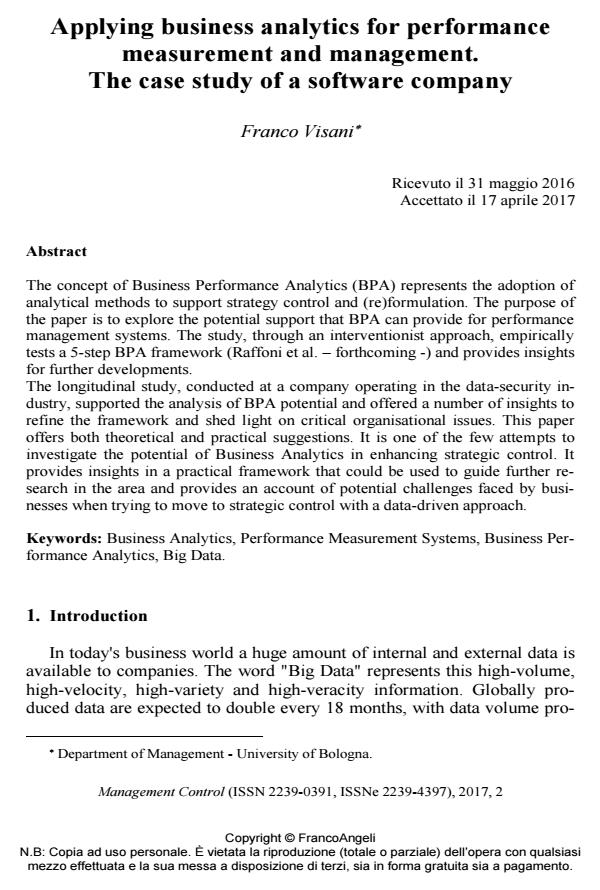Applying business analytics for performance measurement and management. The case study of a software company
Titolo Rivista MANAGEMENT CONTROL
Autori/Curatori Franco Visani
Anno di pubblicazione 2017 Fascicolo 2017/2
Lingua Inglese Numero pagine 35 P. 89-123 Dimensione file 737 KB
DOI 10.3280/MACO2017-002006
Il DOI è il codice a barre della proprietà intellettuale: per saperne di più
clicca qui
Qui sotto puoi vedere in anteprima la prima pagina di questo articolo.
Se questo articolo ti interessa, lo puoi acquistare (e scaricare in formato pdf) seguendo le facili indicazioni per acquistare il download credit. Acquista Download Credits per scaricare questo Articolo in formato PDF

FrancoAngeli è membro della Publishers International Linking Association, Inc (PILA)associazione indipendente e non profit per facilitare (attraverso i servizi tecnologici implementati da CrossRef.org) l’accesso degli studiosi ai contenuti digitali nelle pubblicazioni professionali e scientifiche
The concept of Business Performance Analytics (BPA) represents the adoption of analytical methods to support strategy control and (re)formulation. The purpose of the paper is to explore the potential support that BPA can provide for performance management systems. The study, through an interventionist approach, empirically tests a 5-step BPA framework (Raffoni et al. - forthcoming -) and provides insights for further developments. The longitudinal study, conducted at a company operating in the data-security industry, supported the analysis of BPA potential and offered a number of insights to refine the framework and shed light on critical organisational issues. This paper offers both theoretical and practical suggestions. It is one of the few attempts to investigate the potential of Business Analytics in enhancing strategic control. It provides insights in a practical framework that could be used to guide further research in the area and provides an account of potential challenges faced by businesses when trying to move to strategic control with a data-driven approach.
Parole chiave:Business Analytics, Performance Measurement Systems, Business Per-formance Analytics, Big Data.
- Opportunities and risks in using big data to support management control systems: A multiple case study Francesco Badia, Fabio Donato, in MANAGEMENT CONTROL 3/2022 pp.39
DOI: 10.3280/MACO2022-003003 - Artificial Intelligence in Accounting and Auditing Federica De Santis, pp.1 (ISBN:978-3-031-71370-5)
- Digital technologies and the evolution of the management accounting profession: a grounded theory literature review Daria Arkhipova, Marco Montemari, Chiara Mio, Stefano Marasca, in Meditari Accountancy Research /2024 pp.35
DOI: 10.1108/MEDAR-07-2023-2097 - What Makes Business Intelligence & Analytics Systems Stick? Identifying Recurrent Enablers in Management Accounting Practices Walter Lasca, Marco Montemari, in MANAGEMENT CONTROL 2/2025 pp.133
DOI: 10.3280/MACO2025-002007
Franco Visani, Applying business analytics for performance measurement and management. The case study of a software company in "MANAGEMENT CONTROL" 2/2017, pp 89-123, DOI: 10.3280/MACO2017-002006